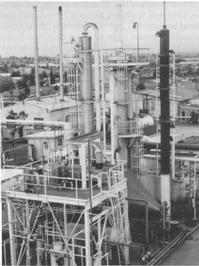


Chapter 9
I Introduction
II The Australian Chemical Industry
III Pharmaceuticals
IV Chemists In Other Industries
V The Dawn Of Modern Chemical Industry - High Pressure Synthesis
VI The Growth Of Synthetic Chemicals - Concentration, Rationalisation And International Links
VII Australian Industrial Chemical Research Laboratories
i Australian instrument inventions
ii Plant protection - overseas and in Australia
iii Successes in the laboratory but . . .
iv Drugs for sheep and cattle revisited Tetramisole - international success and local manufacture
v 'Promicide'* 'Grenade'* to control ticks
vi Technical service R&D
vii Industry/CSIRO/university collaboration
viii Australian entrepreneurs in modern chemistry
VIII The Plastics Industry
IX The Paint Industry
X Acknowledgements
References
Index
Search
Help
Contact us

Drugs for sheep and cattle revisited
Tetramisole - international success and local manufacture (continued)
Tetramisole is a racemate, that is, it consists of two mirror-image isomers otherwise identical (optical isomers) of which only one is biologically active. This is not uncommon in biologicals, but separation of isomers usually involved a series of cystallisations with complementary optically active compounds or complex stereosynthesis. This was just the type of specific challenge in which the late Bob Dewar relished. Once again he postulated stereospecific relationships and 'designed' a few speculative molecules. His colleagues could never quite decide what was scientific vision and what intuition -yet the improbable, almost miraculous happened. He and his 'old faithfuls'[105] found a reagent which produced the desired 1-isomer in high purity and yields of over 90 per cent in a single, extremely simple step. What is more, the useless d-isomer could be converted into the starting material (d,l-tetramisole, the racemate) so that almost quantitative conversion to the active compound was possible. Not only was this elegant and economical, it was technically most valuable, since the racemate tetramisole had a lower safety margin in sheep than some of its competitive products: 1-isomer was doubly safe and fully competitive (Fig. 22).

The discovery of this resolution process had taken a little longer than the synthesis, but came well in time to secure ICI Australia's position as a producer and international licensor. ICI and ICI Australia jointly developed the product world-wide; in Australia it proved to be of major benefit to farming, obtained a dominant market share and in contrast to some of the earlier drugs remained effective for decades. Compatibility with multiple vaccines[106] was demonstrated subsequently and meant a further labour saving for the farmer. Plants were built in Sydney in 1971 and 1976 and manufacture was licensed in the USA, UK and Argentina. Over the years licensees, including the parent company, paid over $10 million in royalties and after the formation of the joint ICI/Wellcome subsidiary Coopers Animal Health worldwide, ICI Australia became the sole producer for the ICI family, with up to 60 per cent of total production for export (1985 market value about $A15 million).
Objective reflection on the case history leads to some conclusions relevant to research from a relatively small basis in Australia. Without insights into the parent company's intelligence, its major contributions in toxicology, product development and even international licensing ICI Australia could hardly have broken into the field -but without ICI Australia's inventions ICI might not have led. It clearly was not a zero sum game, both sides and both countries gained.
Organisations in Australian Science at Work - Coopers Animal Health; I.C.I. Australia Ltd; I.C.I. Australia Ltd. Central Research Laboratories
People in Bright Sparcs - Dewar, R. A.
 |
Australian Academy of Technological Sciences and Engineering |  |
© 1988 Print Edition pages 689 - 690, Online Edition 2000
Published by Australian Science and Technology Heritage Centre, using the Web Academic Resource Publisher
http://www.austehc.unimelb.edu.au/tia/655.html